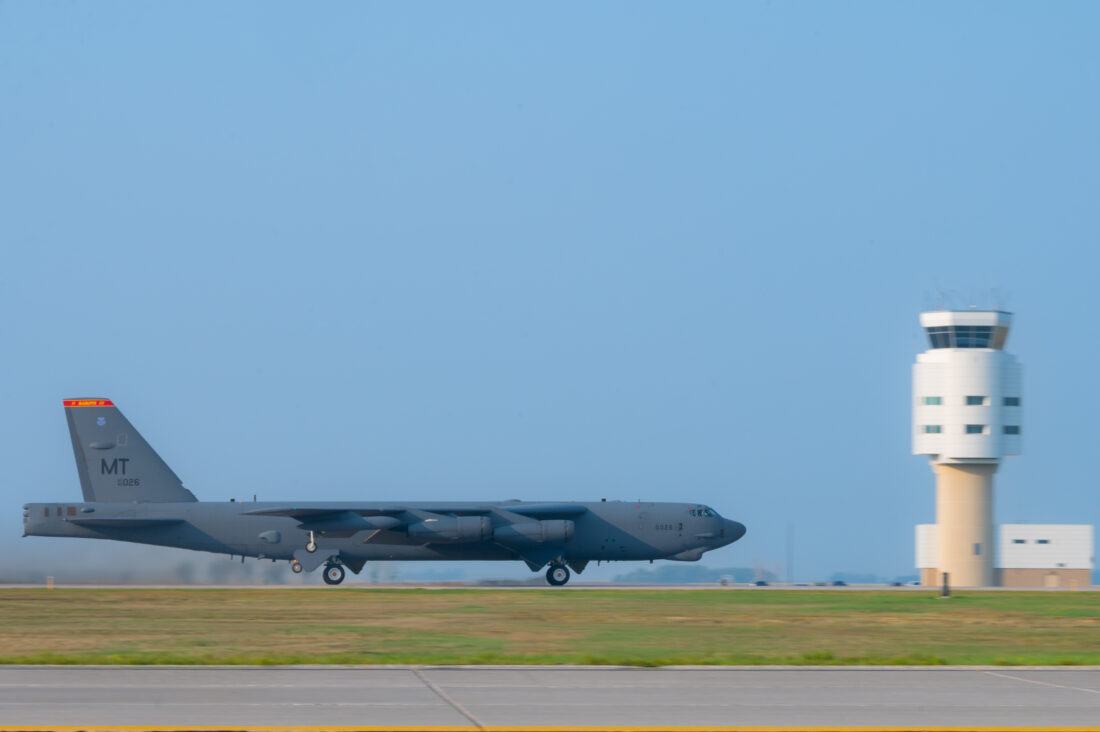B-52s, bombers provide global reach, power
Upgrades coming to B-52s to fly longer

Submitted Photo A B-52H Stratofortress assigned to the 5th Bomb Wing takes off at Minot Air Force Base in this Sept. 6, 2023, photo. B-52s have had a critical role in the deterrence mission for the U.S. for more than 60 years. Minot AFB photo.
Upgrades of the B-52 Stratofortress are necessary to give the plane a longer flying life, according to the commander of Eighth Air Force and Joint Global Strike Operations Center.
Maj. Gen. Jason Armagost is the commander of Eighth Air Force and Joint-Global Strike Operations Center (J-GSOC) at Barksdale Air Force Base, Louisiana.
In a recent presentation with Houston Cantwell, senior resident fellow with the Mitchell Institute for Aerospace Studies, an independent, nonpartisan policy research institute in Washington, D.C., Armagost said reengineering the commercial engine replacement program for the B-52 and the radar modernization program are both taking an iconic aircraft and essentially building those new capabilities in. He said it’s more than just engines and radar but there’s systems’ upgrades that go with it.
“From an engineering perspective, it can continue to fly for even longer. But it does require those upgrades that will make possible different concepts of operation and different ways of conducting missions,” Armagost said.
Some delays in the B-52s upgrades have occurred.
Sen. John Hoeven, R-ND, said, “Upgrades to the B-52, including the new engine and radar modernization, have faced some delays due to technical challenges and program restructuring. We continue working with the Air Force to fund the initiatives and move these efforts forward. The B-52 remains central to the Air Force’s nuclear deterrence strategy, and these upgrades will ensure the aircraft can continue to serve for decades to come.”
Armagost is a combat pilot with fighter and bomber experience who was commander of the 5th Bomb Wing at Minot AFB from July 2014-June 2016.
B-52s, B-1s, B-2s
Armagost said the B-52, B-1 and B-2 bombers are three very different planes and that translates to very different capabilities, but all of them have the ability to carry diverse weapons.
“At their inception, they were all dual capable, meaning that they were nuclear and conventional, and that’s different now by treaty. But that ability to extend power globally is critical,” he said.
He said one of the drum beats with U.S. forces is what it has is being overcome by time or history.
“You have to do something different with what you have as well,” he said.
He referred to Bomber Task Force, a mission for bombers to operate from unfamiliar locations and integrate with allies and partner nations.
“What we saw over the development of the Bomber Task Force is very interesting with regards to our partners and allies and how they integrate with us, how they operate with us, how we communicate with them, how we train with them. That has actually spiked kind of a hunger from the combatant commanders, the regional commanders in particular, for that activity,” Armagost said.
He said Bomber Task Force has been a big transition piece that is inherently a deterrent to the adversaries we face.
“They struggle with finding partners and allies that have real credibility and capability, and we are building that resilient network of partners and allies, in my case, through the Bomber Task Force in particular,” he said.
The B-21 Raider is being added to the U.S. Air Forces fleet of bombers.
Bombers vs fighters
During a question and answer portion, retired Lt. Gen. Robert Elder, a former commander of Eighth Air Force and U.S. Strategic Command’s Joint Functional Component Command for Space and Global Strike, who also has been commander of the 5th Operations Group and 5th Bomb Wing at Minot AFB, asked Armagost what he would like fellow airmen to better understand about bombers versus fighters, not only in joint combat operations but also the operations that bombers are involved with all the time.
Armagost said the spectrum of capabilities is amazing.
“Bombers are an order of magnitude difference in what you can do with them,” he said. Giving an example, he said, “In 2004, I happened to fly an operational test mission where we tested the carriage of 8,500 pound JDAM’s (Joint Direct Attack Munition) and released them all in a span of a little over 20 seconds on an airfield in the UTTR (Utah Test and Training Range). That’s an amazing sight to behold.
“I would contrast that with an experience in 1997,” he added, citing his experience in a range in Korea. “We carry two 2,000-pound bombs, which was also amazing because it was a low delivery and you could feel everything happening, but it’s just an order of magnitude different. Now, they nest incredibly well together.
“We see that with our partners and allies who, for the most part, they fly fighters as their power projection capability. But when we nest them together with bombers, it is a completely different animal. It draws the attention just like the run-up to Midnight Hammer did,” he said, also noting, “It’s just an order of magnitude difference in what you can do and what is possible with bombers.”
Today’s airmen
Armagost said he’s routinely impressed with today’s young airmen.
“They’re very, very good and very, very well informed about things in ways that certainly I was not when I was their age. I’m inspired by their depth of knowledge and their kind of the spectrums of knowledge they bring to a problem set,” he said.
He said many people do not realize how young the forces are.
“When I was a wing commander at Holloman (Air Force Base in New Mexico), someone told me that we had 1,800 first-term airmen at the base,” he said. He didn’t believe it but discovered it was true.
“There are a lot of young airmen doing amazing things,” he added.
Reflecting on his time as wing commander at Minot AFB, he said meetings he never missed unless he was off-station were the first-term airmen discussion.
“Because in a place like Minot, where you’re kind of in north central North Dakota and you’re getting airmen from all over the country, I want to make sure that they are welcomed in a way that says what they do is important because it is,” he said. “We see how important it is only in the totality of what comes out. And it’s really impressive. We owe them the best opportunities that we can give them.”

